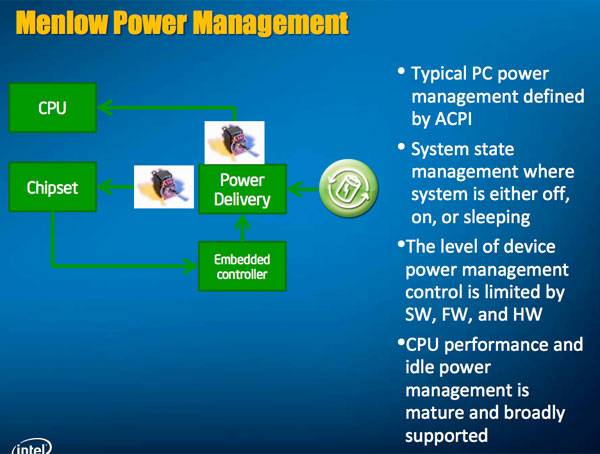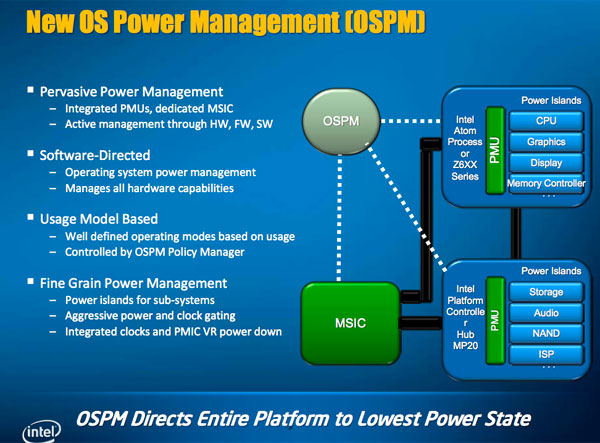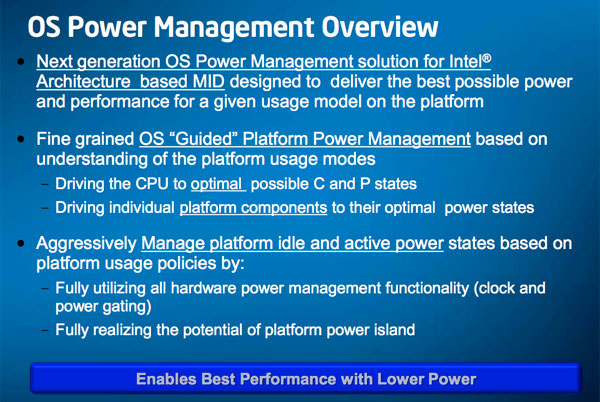Intel Unveils Moorestown and the Atom Z600, The Fastest Smartphone Platform?
by Anand Lal Shimpi on May 4, 2010 11:54 PM EST- Posted in
- Smartphones
- Intel
- Atom
- Mobile
- SoCs
OS Driven Power Management
When Intel introduced Nehalem and the Core i7, we saw a new generation of power engineering in microprocessors. In the past, the OS would request a particular performance state from the CPU and the chip would respond by changing its clock speed. Nehalem’s Power Control Unit (PCU) instead dedicated enough transistors to build a 486 to monitoring the power and performance demands on the chip. Based on those demands and what the OS was doing, the PCU would power up or down individual cores, as well as move clock speeds up or down. The PCU would guess at what the OS was trying to do and respond accordingly.
Nehalem and its successors were massive chips, eating up to 130W of power under load and idling down in the 6 - 10W range. Lincroft has to be sub-1W under load and 6mW at idle. With even more stringent power demands and a much smaller die, Intel couldn’t blow a sizeable percentage of the Lincroft transistor budget on power management.

Instead of guessing at what the OS wants, the Moorestown platform uses OS Driven Power Management (OSPM) to tell Lincroft and Langwell what to do. OSPM is supported in Moblin and presumably the Wind River build of Android.

The OSPM process tells the hardware what apps it’s running and to shut down what it doesn’t need. There are well defined operating modes - standby, internet browsing, MP3 playback, video playback, voice call, video capture, etc... Based on the profile, the hardware doesn’t have to guess at what it should turn off/on, it just does it right away.
The OSPM driver communicates directly with the two power management units in Moorestown - one in Lincroft and one in Langwell. It instructs those PMUs to shut off various blocks, and in turn they tell Briertown to gate and cut voltage to the parts of chip that aren’t needed.

I wondered if this couldn’t be done in hardware, but it seems that given current die constraints and the sort of accuracy of information it needs Intel must implement at least some of the power management control in software. Toolkits will be available for developers to control the OSPM.










67 Comments
View All Comments
strikeback03 - Thursday, May 6, 2010 - link
Actually, at least on Verizon, there are not many phones that last more than 2-3 days with relatively light use (5-10 min talk, 20-30 txt per day). This is actually something that has gone down in the past few years, as even basic phones get flashier UIs and use more power to run them. And while I support having some phones with weeklong standby time, I am fine with charging my phone or switching batteries every night so long as the phone can last a day in moderate use, which the Snapdragon phones typically can. I like to be able to access more than talk and text on the go.v12v12 - Monday, May 10, 2010 - link
WOW... standing ovation... All of my Droid friends are laughable! Constantly tethered to a power outlet! Always doing something useless and for sure entertainment Vs thinking quietly with their minds... pretty soon "dude I gotta go, my phone is about to die," yeah umm just how many hours have your spent actually TALKING on the dang thing vs playing around with it constantly like some personalized TOY?Battery life should be much more focused upon... The cattle-minded consumers are at it again; now tell me, had to only have 1 car, would you also buy a car that gets the WORST miles per gallon, but has a bunch of silly go-fast features that have you constantly at the fuel pump Vs getting to where you need/should be? Course that's why people usually own 2 cars to separate those needs Vs desires.... Today's "Ferrari" phones have the everyday idiot rambling along, bumping into shit, with their heads constantly fixated on the "screen," like drones. Talking...(?) haha you rarely see people talking with these things, it's just constant "entertainment," even in the most hindering places and social situations. So everyone's got a "Ferrari" phone, but end up trying to use it like a honda; sorry it just doesn't work like that. Faster = more fuel, LESS actual usefulness.
__I'd rather have a phone with a decent amount of enjoyable features, that I can actually take with me on a trip to places that may or may not have power ON-DEMAND lol..
juampavalverde - Wednesday, May 5, 2010 - link
The article and the new product is really interesting, but intel aint ready yet for smartphones, actually this moorestown platform looks much more interesting for pads and handhelds, having more space for such amount of chips, also being x86 with a custom linux. something like an ipad powered by this kind of atom starts to make sense, both from the performance and the battery lifeWorldMage - Thursday, May 6, 2010 - link
The interesting thing about all of the power draw figures given is that they were for workloads wherethe ATOM would be doing almost nothing. Video decode is done by the video decode HW where the
atom might wake up every few seconds to load the next batch of data, similarly for audio playback and
talk time (as you point out cellular modem is the only thing doing work). The thing that gets closest is web browsing, but assuming they are browsing 'static' pages (i.e. no Flash) the atom does a bit of work and probably sits essentially idle for easily 90% of the time.
So it's not surprising they are in the same ballpark as other SOC's for those workloads since they seem to essentially be using the same HW blocks as the competing SOC's. I think it's very telling that all of the power consumption figures from Intel were for essentially non-Atom work loads.
To which you might say "so what?" if those are the work flows that you care about, but that would ignore the fact that the whole point of the atom is to enable "fancy" UI's (and perhaps games) with lots of animation and stuff happening in the background and actually making use of the power of an ATOM.
If you can't actually power the ATOM for an hour of actual use (browsing contacts, checking flights, web pages with Flash ads etc) won't the smart phone be almost worthless?
Th3Loonatic - Thursday, May 6, 2010 - link
On page 3 of the article you misnamed the chips. The one on the left is Lincroft and the one on the right is Langwell.Electrofreak - Friday, May 7, 2010 - link
Anand, Cortex A8 on the 65 nm feature size is reported to use about 0.59 mW per MHz under load, and Cortex A8 on the 45 nm feature size is reported to use 20-30% less than that. For a little bit of added beliveability, Qualcomm's Snapdragon sips in the vicinity of 0.5 mW per MHz on the 65 nm scale, though that may be under optimal circumstances / marketing spin.Ultimately it's roughly half the power consumption Moorestown is reporting. And we notice that nowhere does Intel actually compare their power consumption figures to ARM's.
Additionally, I was under the impression that the A4 had a dual-channel memory controller. I would guess LPDDR2 memory as well, but your guess is as good as mine.
I suspect the S5L8930 in the A4 is a PA Semi (remember Apple bought them) reworked Samsung S5PV210, the dual-channel controller tablet / MID-oriented sister chip to the Samsung Hummingbird S5PC110 (which uses a single-channel controller with LPDDR2 support, if my resources are to be trusted.)
pradeepcvk - Tuesday, November 1, 2011 - link
Anand liked your brief of S0Ix wrt Meego. I wonder how would it work with windows ACPI.could you please have an article for the same.